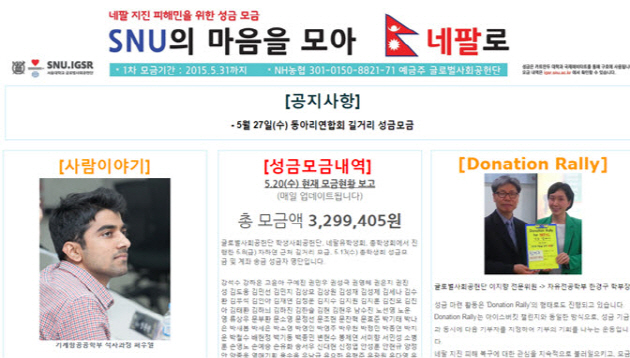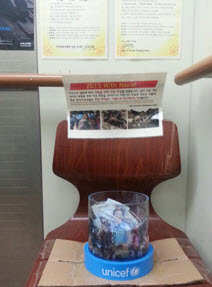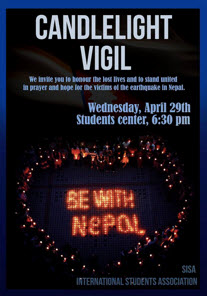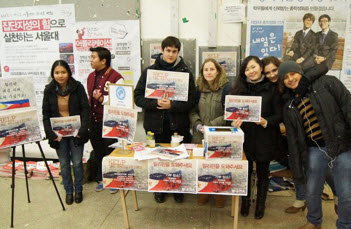Throughout the years the Seoul National University (SNU) community has participated in relief efforts to aid groups that have been affected by disasters both domestically and internationally. Three particularly devastating incidents saw the SNU community unite and concentrate its energy on creating a positive and lasting impact. These were the typhoon Haiyan that ravaged the Philippines in 2013, the sinking of the Sewol ferry in 2014, and the devastating 7.8-magnitude earthquake that hit Nepal in April this year. The events generated increased solidarity within the Seoul National University community.
Comprehensive Response to Nepal’s Earthquake

SNU Institute for Global Social Responsibility is raising fund for Nepal earthquake victims
The most recent natural disaster that has caused extensive damage and grief is the earthquake that affected Nepal in late April of this year. The earthquake hit on April 25 with a magnitude of 7.8. It has killed over 8,000 people thus far, and has injured more than 19,000. UNESCO World Heritage sites located in Kathmandu and homes have been destroyed, leaving hundreds of thousands of people without shelter. The devastation brought on by the earthquake means that Nepal will face unimaginable challenges ahead.
Diverse groups in Seoul National University have responded to the tragedy that has resulted from the earthquake. The Seoul National University Hospital has donated medicine and medical supplies worth 100 million KRW as requested by Dhulikhel Hospital (Kathmandu University Hospital). In addition, Seoul National University’s Institute for Global Social Responsibility (SNU-IGSR) and Scientists and Engineers Without Borders (SEWB) have jointly donated 600 water filters to provide clean water to the people affected by the earthquake.

Donation boxes in the dormitory
SNU-IGSR, in collaboration with the SNU Student Council for Social Responsibility, the SNU Student Union, and the Nepalese Student Association, has launched a campaign to collect donations that will be sent directly to Nepal. It has installed donation boxes near Jaha pond and will also be selling Nepalese food during the SNU Spring Festival to bring more focus to the cause.
The SNU dormitory, Gwanaksa, has established donation boxes on every dorm building, as well as near the entrance of every dining hall. These donation boxes are part of the “Change for Good” UNICEF campaign and have posters that provide a brief explanation of the earthquake that has affected Nepal. In addition, the administrators of Gwanaksa have also clarified what difference donations can make. For example, 10,000 KRW can provide ten bags of powdered milk for malnutrition, while 40,000 KRW will provide 5,000 water purification tablets to prevent dysentery.

SISA (SNU International Students Associations)
held a candlelight vigil on April 29
for Nepal earthquake victims.
In addition to the donation boxes set up by Gwanaksa, symbolic gestures have also been organized. The SNU International Students Association (SISA) held a candlelight vigil in the Student Center a couple of days after the earthquake hit Nepal. On its Facebook page, SISA issued a statement: “Words are not enough to express the grief and pain after the catastrophic earthquake hit Nepal and left a somber trail of thousands of lost lives, destroyed homes and a huge crisis. We at SISA would like to invite you to honor the lost lives and to stand united in prayer and hope for the victims of the earthquake in Nepal. We will meet tomorrow for a candlelight vigil at 6:30 PM in front of the Student Center.” In addition to the symbolic gesture, SISA announced that during its International Food Festival held at the SNU Spring Festival, it would set up a donation box near the food booths to receive donations for those affected by the Nepal earthquake.
Efforts in Response to the Deadliest Typhoon in the Philippines
In early November of 2013, the Philippines was affected by one of the strongest tropical cyclones ever recorded in modern history, Typhoon Haiyan. This deadly typhoon killed over 6,300 people in the Philippines alone, and more than six million were displaced. Typhoon Haiyan also caused extreme damage to infrastructure around the country. As a response to the devastation caused by Typhoon Haiyan, SNU students organized raised donations to send to the Philippines. The SNU International Students Association opened donation spots for students and faculty of SNU to donate.

Students raised 1760 USD for victims of Philippines Typhoon in 2013
Placed in two of the most populated locations on campus, the first floor of the Student Center (Building 63) and in the cafeteria of the SNU dormitory, the members of SISA stood in the donation booths from early in the morning until late in the afternoon holding poignant posters with the words ‘Help the Philippines’ for people to donate.
The donation drive went on for four days and SISA was able to gather a total of 1,914,340 KRW (approximately 1,760 USD) which was delivered to the International Red Cross. SNU Country Representative of the Philippines, Ms. Eva Marie Wang posted on Facebook her appreciation for the donations. “We are very grateful to SISA for joining the movement in helping those affected by Typhoon Haiyan. We will never forget your initiative and we appreciate everyone who participated in this fund-raising drive. May SISA grow and be blessed all the more.”
Mourning the Sewol Ferry Incident
In April 16 of 2014, the sinking of the Sewol ferry shook the nation. The ferry had been carrying 476 people, mostly secondary school students from Danwon High School, from Incheon to Jeju Island. Of the total number of passengers on board, 304 passengers died in the disaster. The capsizing of the Sewol ferry sparked anger throughout the nation, and criticism of the actions of the captain and crew of the ferry and the ineffective rescue operations arose.
A year after the tragic sinking of the Sewol ferry, people all over the nation have mourned over the loss of the victims. The fact that calls for the government to create an independent investigation team to uncover the reasons behind the appalling sinking have not been met, has added anger and frustration to the grief. This April, there were yellow ribbons hung on trees around the Seoul National University campus. The yellow ribbon originally expressed the hope that some sort of miracle might occur during the early days of the Sewol ferry sinking. Subsequently, it has become a symbol of solidarity for the tragedy. During the actual week of April 16 of this year there were various activities organized by students to show respect to the victims.
During the week there were several performances in front of Jaha pond. There was one particularly poignant performance, a seemingly spontaneous modern dance. A group of students suddenly rushed to the middle of the walkway and, in sync with the dramatic, climaxing music, flung their arms in the air, as if they were seeking for air in desperation. They also spun around and dropped to the floor, as if being swept away by the strong currents of torrential waters. In certain parts of the performance, the students produced yellow handkerchiefs from their pockets, and acted as if they were scribbling messages, desperate messages, on the piece of fabric. Suddenly as the music ended, the group of students and continued to walk in the same paths as they had come. Such a performance stunned those watching. Perhaps it served as a reminder of the uncontrollable grief and sorrow, the sense of futility created by the tragedy. (See picture below)
Performances can be found online on Youtube:
https://www.youtube.com/watch?v=r3zmEiiqecE
https://www.youtube.com/watch?v=UcjVOo5DMxc
In addition, artistic representations of the events surrounding the Sewol ferry tragedy hung between trees in front of Jaha pond. Photographs of the victim’s families, the ongoing protests and the desperate wishes for miracles written by people all over the country were displayed.
Martin Luther King Jr. stated, “Life’s most persistent and urgent question is, “What are you doing for others?” As an institution that has received significant aid during its early years of foundation, SNU understands the need to take action during difficult times. There is nothing pleasant about disasters, of the unpredictable catastrophes that result in loss of human lives and the destruction of cultural and historical sites. The suffering and sorrow felt by those directly and indirectly affected by such disasters cannot be easily overcome, and must not easily be forgotten. As a community that may appear to be completely unrelated to such occurrences, SNU has demonstrated the fundamental desire we all possess to provide aid and warmth in both symbolic and practical manners.
Written by OH Jung Eun, SNU English Editor, josefinaoh@snu.ac.kr
Reviewed by Eli Park Sorensen, SNU Professor of Liberal Studies, eps7257@snu.ac.kr

